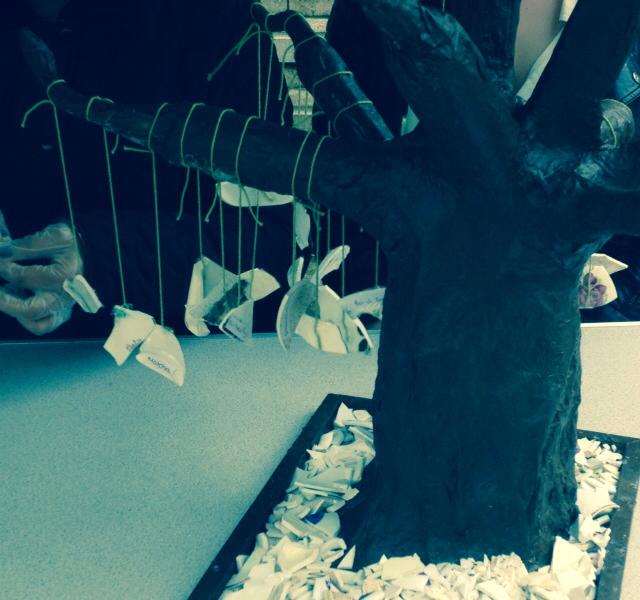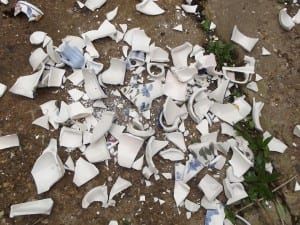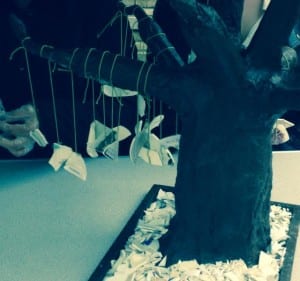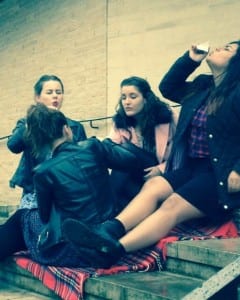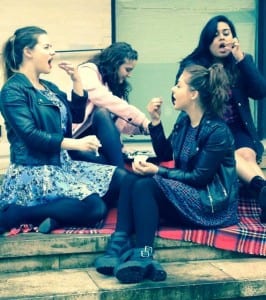Framing statement
“This term refers to a staging and performance conceived on the basis of a place in the real world (ergo, outside the established theatre). A large
part of the work has to do with researching a place, often an unusual one that is imbued with history or permeated with atmosphere: an airplane, unused factory, city neighbourhood, house or apartment” (Pearson, 2010, p.7) in relation to this quote and our site specific location and performance which was held at the collection and museum. Throughout the process I had to develop my knowledge and understanding of the history of the location which was the most important key when it came to developing your site performance. I had to acknowledge the space, responded to the space and the audience. In my group majority of us focused on room, gallery three and the idea of what values the crockery has for them to be allowed into the gallery and throughout our process we began to discuss the crockery and what happens to the crockery that isn’t valued into the gallery.
With this in mind we started to allocate our performance, straight away we knew we wanted to perform outside because of the boundaries/restriction inside the gallery. That’s when it leads us to outside the collection, and the café in the museum. We discovered a beautiful space just right outside the café which then allowed us to have the cafe customers as our audience. We found out we’d be performing over the space of two days, so as a group we came to an idea that we wanted to process our performance which would turn our performance into a durational piece.
The first day would be us curating the broken crockery for however long that will take us with a video and audio playing for our audience to hopefully take interest in and on the Saturday we’ll finish the final product we’ve been working on in our process. Our audience will hopefully become interested and intrigued on what’s going on outside the café, optimistically this will make them feel the need to come out and interact with us to question us on our piece. Right from the start our ideas have changed quantities of time but we’ve always stuck to the idea of the broken crockery, we’ve gone from looking into making audio of different stories for our audience to listen to and them doing the breaking and creating to the imp of Lincoln to then talking and hearing about the Boston tea party which lead us to our final idea of being the focus around tea the camellia sinensis tree which creates 3000 different types of trees. We hope when it comes to our final performance that everything links and we manage to justify ourselves to the audience.
Exploring from the beginning
We were told to bring in something we collect and in this past seminar I got to experience what each person collected. By viewing everyone’s collected items I sensed individuality and uniqueness which allowed different stories to be told on why people collected these certain items. I personally collect memories, and therefore I brought in a gift tag and a message from one of my best friends back home wishing me good luck for university life. Even though the memories are in my head, I keep these items to trigger off memories which have gone to the back of my mind. I witnessed a collection of James Usher’s artwork in the gallery where we will be performing our Site-Specific work. In contrast to his collection which is all on show for the public, my own collection remains in a box and hidden away. We had to categories our collection to which heading we thought our collection belonged in, there was domestic, belonging, national, and conventional. When it came to me presenting mine Ally added another heading which mine belonged in called marking time/place/ownership which my box of memories relates to all three. Upon our visit to the collection in gallery three there was a collection of pocket watches and straight away it triggered memories of my grandad who himself has a collection of pocket watches at home which all so made me think of the mornings lesson. The collection is full of collected items which James Usher composed for this house, so I feel this morning’s task was a good reflection on what a gallery and museum is a variety of different collections.
Connecting with the space
Over the past few months some of the readings we had have been difficult to read and understand, performing in a museum/gallery has been a challenge but a challenge we have overcome. One reading we had made me think that performing in the collection is in some relation like a theatre, the reading was called theatre and museums by Susan Bennett “In short, both theatre and museums require an infrastructure supported by a diverse range of technical and intellectual skills, acts of interpretation mediation, and, eventually, an audience.” (Bennett 2012,P.2) Through our process of finding out about the gallery, we found that each room has a certain temperature and technical lighting so paintings don’t fade or get ruined. You don’t think about the fact that a gallery needs an audience just as much as a performance does, in my own opinion I don’t tend to visit gallery’s and the people I worked with themselves said there not ones to visit gallery’s. It’s nice to see theatres and gallery have things in common. Another point made in this reading was about how we perform the things we now and create and that’s the same for a gallery they put on show “Exhibitions are fundamentally theatrical, for they are how museums perform the knowledge they create” (Destination culture, 1998, p.3) (Bennett 2012, p.3)
Another reading that took my interest was performing the museum he states “Performing the museum is a dialogic process, a play between the public narratives of the museum and the private narratives of viewers” (Garoian 2001,P. 239) how each person has a different view on what’s been seen and what’s been told and this could create a form of dialogue, me and my group questioned the public in the gallery about what they thought to descriptions on the wall, if they believe the facts they were been told and one man answered us with the answer no, he prefers to make up own solution on what is happening in the painting or picture and many other items place around the collection. From my own personal opinion I’d believe the descriptions in the galleries.
Practitioner’s influences
Today’s lesson we got to get an insight of different practitioners and their site specific work. Every time we watched a new practitioners I was taken back from their work and it still made me question what site specific is because each practitioners performance was so different, I know each one should be different which gives them originality but to me they were strange and I didn’t understand the concept of them. However there was a couple that stuck out to such as Kidnap blast theory – 1998, were the audience got to participate in a kidnap, the audience volunteered themselves, this one made me want to actually experience’s their performance, because it’s something so diverse and not what you’d expect a performance to be. One I truly enjoyed to watch because I loved the concept behind was the company, Mad For Real, were they used two sauces (soya and tomato) that represented the east and the west and it happened around a time when there was riots in London, when watching the video people actually stopped rioting to watch this performance although they didn’t know it was a performance happening. In lesson we discussed how you’re an audience member whether you like it or not but because of the space they perform it in it allows you to leave, I looked on to their website to look at different projects http://www.madforreal.org/ketchup.html(accessed April 29th) I saw that the did the sauces project in so many different places, such as Greece and they also performed in two gallery’s, one outside a gallery in London and then one inside a gallery which is so surprising to say how many restrictions there is in a gallery. Later on in the lesson I discussed with a group which one seem to inspire us, the one that got brought up the most was, SFMOMA scavengers, 2006. The practitioner turns the audience into the artist by getting the audience to collect items and make their own exhibition in a gallery. Me and the group I discussed this with all saw this company as an influence’s towards our group working in a gallery we felt like this is one we could relate to and get ideas from. When I and my group were think of ideas we discussed collected unwanted crockery from people we knew and asking for their story of why they didn’t want it no more and if there’s a story behind this mug. As a group we felt like our idea was about to come together. We started to collect unwanted tea sets from charity shops.
Tasks
Throughout the process we’ve had a variety of task set for us. The tasks we got sent this week started to reflect on the space we’ll be performing in, I’ve only just really understood the reason to these task’s though. I didn’t understand the reason to them when we were doing them in lesson. We had our own personal task set which mine was to find a piece of art that represented silences. I started off in the museum walking round I didn’t feel much silences because a lot of the things seem to be from the Stone Age I imaged loudness. As you walked through different periods of time I seemed to focus on changes and madness of changes. So I moved on to the collection I was walking round looking and paintings and statues and reading the definition it gave you. I came across Fred wards picture of four photographs taken of Jaqueline Kennedy on her husband’s assassination and then at his funeral. All four pictures were in black and white and straight away for me when I think of funerals I think of silence but I still didn’t think a picture justified what silence was in a gallery. The more I walked round and thought about silence the more I thought of the gallery and the volume of a gallery. I started to feel that the gallery as a whole represents silences and when it got round to sharing your thoughts with the class a question got brought up to Ash about if there was any requirements on the volume you have to be in a gallery and he told us that there isn’t one, which as a class we all found shocking. This to me and my group was an advantage as we are using loud audio of smashing crockery.
Pitching ideas
Challenges we faced in the pitch today was justifying our ideas. Thinking about the creative concept and if it’s appropriate for the collection, our practical requirements, the audience relationship i.e. the invitation/the contract. Our idea of representing the crockery that isn’t seen as valuable into something creative, so in our pitch we tried to justify our reason such as speaking about how the items in the museums only represent one truth as they’ve been displayed. Broken items or items that have been used also often have more of a story then those which have been persevered and unused. When it came to the end of the pitch we took all the feedback on form because as a group I think we didn’t feel very confident with our pitch it was nice to get a response to guide us into the right direction. Ally started by telling us we need to find how to curate all our broken items. Conan liked the thought of broken crockery but it was finding a different path to go down rather than the audiences doing the breaking and the making it was going to have to be down to us, he liked the idea of a tea party so what we had to take away from the pitch was we had a solid idea and a starting point it was more on find the middle what was starting to look a struggle.
Film Process (Copyright, Mia Kaur)
Curating with ash
Myself and bryony went to the gallery on the second day of them curating in the black room, which they change every three month, which I think is exciting and a great idea for a gallery. However when we turned up Ash told us they managed to get it done all in one day so he stepped through it with us. He started off by telling us each person has their own assigned job. He took us through all the material they used, such as cotton cloth for the tables, latex gloves, acid free paper to wrap the art into and foam cover for even more protection. Luckily ash had some spare acid free paper and foam material to give us, which was a real help. He then shared with us the condition statement form they have to fill out for each piece of art which he kindly printed out for us, for if we needed to make one for our performance. He also printed off a timetable of what’s happening on what day and when and which person will have which assigned job. We had a better idea now how to wrap up our broken crockery and how to curate it and hopefully it will come across professional and interesting on day of performing.
Final Challenges
We worked with our second filming of smashing the broken crockery https://www.youtube.com/watch?v=LadHUSttw8A&feature=youtu.be(accessed may 9th) I know personally I found this a strong point going towards our performance. It’s been a challenge with us changing our idea at the very last minute the last part of rehearsals have been intense but it’s definitely what we needed. We had an advantage though with getting all our broken crockery sorted. In the upcoming weeks before our performance it was about finding the teas and making the camellia sinensis tree. We functioned well setting each other task and working on certain things when we got together. We did work well as a group and that helped us get to the stage we wanted in such a small space of time. We had everything sorted and made ready for when we performed. We used a canvas to write out a family tree of the different trees, we choose not to use all 3000 teas because we felt it wouldn’t have the same affect but we could have maybe done with writing that the camellia sinenis does create 3000 different types of tea. However we did show the five main types, which were Indian, Chinese’s, Japanese, compressed and herbal. We were nervous about the outcome of the tree but when we began to add the final touch’s we got excited that potential it could turn out to look striking, now it was just down to performance day.
Conclusion
Our final performance was better than we expected and more enjoyable than we thought, with our performance been a durational piece we thought our about the time we had over the two days “Conventional, theatre runs in event time” (pearson 2010, P.160). Thursday was our day of curating the broken crockery whilst Saturday would consist of making the tree. Thursday feedback made us rethink on our Saturday timetable and we added the curating into our timetable. With our performance space been outside the café our target audience was to get the café members involved and intrigued on what we were doing. I felt that work as we had responses from people inside the café and people coming out of the café to ask about our performance, maybe we didn’t get as many people as we liked but still be got some wonderful feedback from the people that did take interest. I think the purpose of people not been as interested as we like was due to the weather. The weather didn’t stop our attitudes to create the final outcome. I think in future preferences we’d work on the tea party better and maybe focus on the audio making stronger than our morning audio. I enjoyed the tea party, I feel we ended on a nice reflection of a broken “mad hatter tea party” influenced by Alice in Wonderland.
I felt our audio and video were the focus of our performance and the challenges we had on the Thursday was the projection not working onto the tracing paper and the video been too light for our audience to see, we had a backup plan for Saturday to use tablets for the audience to take and have a good look at. Another challenge to overcome in the future would be to make sure our audience fully understands the concept of what’s going on with a suggestion of just a description box around our performance for the audience to read because the audience felt like they couldn’t talk to us during the curating and the making and in our break we had the audience coming us and asking about our piece which was a really nice feeling to know people were interested in our piece and with that I feel like we achieved something spectacular. Our final outcome of the tree was a real delightful feeling because it was all down to how this final piece turned out, we created a camellia sinenis tree through the different teas and it was nice to hear the sound of the broken crockery hitting together. One woman came to have a look and said it look wonderful, she even politely asked to take a photo. I think we achieved something to be proud of.
“Tree” (Copyright, Aylwyn Walsh) “Tea Party” (Copyright, Aylwyn Walsh) “Tea Party 2” (Copyright, Aylwyn Walsh)
Work cited
Bennett, S (2012) Theatre and Museums, Palgrave Macmillan
Cai Yuan and Jian Jun Xi . (). projects . Available: http://www.madforreal.org/projects.html. Last accessed 14 may 2014.
Garoian, Charles R (2001) Performing the Museum, Studies in Art Education Vol. 42, No. 3. (Spring, 2001), pp. 234-248, National Art Education Association
Kaur, Mia (2014) Site Specific [online] https://www.youtube.com/watch?v=LadHUSttw8A&feature=youtu.be [accessed 9th May 2014]
Kaur, M. (2014) Film Process
Pearson, M (2010) Site Specific Performance, Basingstoke Palgrave Macmillian
Walsh, A. (2014) Tree
Walsh, A. (2014) Tea Party
Walsh, A. (2014) Tea Party 2
